Identification of Novel Natural Dual HDAC and Hsp90 Inhibitors for Metastatic TNBC Using e-Pharmacophore Modeling, Molecular Docking, and Molecular Dynamics Studies
Abstract
1. Introduction
2. Results and Discussion
2.1. E-Pharmacophore Modeling and Screening
2.2. Molecular Docking and MM-GBSA
2.3. ADMET Prediction
2.4. Molecular Dynamic (MD)
3. Materials and Methods
3.1. Preparation of Proteins and Ligands
3.2. E-pharmacophore Modeling and Virtual Screening
3.3. Grid Generation and Molecular Docking
3.4. Free Binding Energy Calculations
3.5. ADMET Analysis
3.6. Molecular Dynamics (MD) Simulations
4. Conclusions
Supplementary Materials
Author Contributions
Funding
Institutional Review Board Statement
Informed Consent Statement
Data Availability Statement
Acknowledgments
Conflicts of Interest
References
- Januškevičienė, I.; Petrikaitė, V. Heterogeneity of breast cancer: The importance of interaction between different tumor cell populations. Life Sci. 2019, 239, 117009. [Google Scholar] [CrossRef]
- Siegel, R.L.; Miller, K.D.; Fuchs, H.E.; Jemal, A. Cancer Statistics, 2021. CA. Cancer J. Clin. 2021, 71, 7–33. [Google Scholar] [CrossRef]
- Al-mahmood, S.; Sapiezynski, J.; Garbuzenko, O.B.; Minko, T. Metastatic and triple-negative breast cancer: Challenges and treatment options. Drug Deliv. Transl. Res. 2018, 8, 1483–1507. [Google Scholar] [CrossRef] [PubMed]
- Ressler, S.; Mlineritsch, B.; Greil, R. Triple negative breast cancer. Memo-Mag. Eur. Med. Oncol. 2010, 3, 185–189. [Google Scholar] [CrossRef]
- Vagia, E.; Mahalingam, D.; Cristofanilli, M. The landscape of targeted therapies in TNBC. Cancers 2020, 12, 916. [Google Scholar] [CrossRef]
- Mallipeddi, H.; Thyagarajan, A.; Sahu, R.P. Implications of Withaferin-A for triple-negative breast cancer chemoprevention. Biomed. Pharmacother. 2021, 134, 111124. [Google Scholar] [CrossRef] [PubMed]
- Oner, G.; Altintas, S.; Canturk, Z.; Tjalma, W.; Verhoeven, Y.; Van Berckelaer, C.; Berneman, Z.; Peeters, M.; Pauwels, P.; van Dam, P.A. Triple-negative breast cancer—Role of immunology: A systemic review. Breast J. 2020, 26, 995–999. [Google Scholar] [CrossRef] [PubMed]
- Shahi, S.; Akwii, R.; Sajib, S.; Farshbaf, M.J.; Kallem, R.R.; Putnam, W.; Wang, W.; Zhang, R.; Alvina, K.; Trippier, P.C.; et al. Design, synthesis and structure-activity relationship study of novel urea compounds as FGFR1 inhibitors to treat metastatic triple-negative breast cancer. Eur. J. Med. Chem. 2020, 209, 112866. [Google Scholar] [CrossRef]
- Deepak, K.G.K.; Vempati, R.; Nagaraju, G.P.; Dasari, V.R.; Nagini, S.; Rao, D.N.; Malla, R.R. Tumor microenvironment: Challenges and opportunities in targeting metastasis of triple negative breast cancer. Pharmacol. Res. 2020, 153, 104683. [Google Scholar] [CrossRef]
- Swain, S.M.; Kim, S.B.; Cortés, J.; Ro, J.; Semiglazov, V.; Campone, M.; Ciruelos, E.; Ferrero, J.M.; Schneeweiss, A.; Knott, A.; et al. Pertuzumab, trastuzumab, and docetaxel for HER2-positive metastatic breast cancer (CLEOPATRA study): Overall survival results from a randomised, double-blind, placebo-controlled, phase 3 study. Lancet Oncol. 2013, 14, 461–471. [Google Scholar] [CrossRef]
- Alothaim, T.; Charbonneau, M.; Tang, X. HDAC6 inhibitors sensitize non-mesenchymal triple-negative breast cancer cells to cysteine deprivation. Sci. Rep. 2021, 11, 10956. [Google Scholar] [CrossRef] [PubMed]
- Marmé, F. Targeted Therapies in Triple-Negative Breast Cancer. Breast Care 2015, 10, 159–166. [Google Scholar] [CrossRef] [PubMed]
- Lin, C.W.; Zheng, T.; Grande, G.; Nanna, A.R.; Rader, C.; Lerner, R.A. A new immunochemical strategy for triple-negative breast cancer therapy. Sci. Rep. 2021, 11, 14875. [Google Scholar] [CrossRef] [PubMed]
- Yu, S.; Cai, X.; Wu, C.; Liu, Y.; Zhang, J.; Gong, X.; Wang, X. Targeting HSP90-HDAC6 Regulating Network Implicates Precision Treatment of Breast Cancer. Int. J. Biol. Sci. 2017, 13, 505–517. [Google Scholar] [CrossRef]
- De Ruijter, A.J.M.; Van Gennip, A.H.; Caron, H.N.; Kemp, S.; Van Kuilenburg, A.B.P. Histone deacetylases (HDACs): Characterization of the classical HDAC family. Biochem. J. 2003, 370, 737–749. [Google Scholar] [CrossRef]
- Witt, O.; Deubzer, H.E.; Milde, T.; Oehme, I. HDAC family: What are the cancer relevant targets? Cancer Lett. 2009, 277, 8–21. [Google Scholar] [CrossRef]
- Kaluza, D.; Kroll, J.; Gesierich, S.; Yao, T.; Boon, R.A.; Hergenreider, E.; Tjwa, M.; Ro, L.; Seto, E.; Augustin, H.G.; et al. Class IIb HDAC6 regulates endothelial cell migration and angiogenesis by deacetylation of cortactin. EMBO J. 2011, 30, 4142–4156. [Google Scholar] [CrossRef]
- Fedele, P.; Orlando, L.; Cinieri, S. Targeting triple negative breast cancer with histone deacetylase inhibitors. Expert Opin. Investig. Drugs 2017, 26, 1199–1206. [Google Scholar] [CrossRef]
- Hsieh, Y.; Tu, H.; Pan, S.; Liou, J.; Yang, C. BBA-Molecular Cell Research Anti-metastatic activity of MPT0G211, a novel HDAC6 inhibitor, in human breast cancer cells in vitro and in vivo. BBA-Mol. Cell Res. 2019, 1866, 992–1003. [Google Scholar] [CrossRef]
- Kra, O.H.; Mahboobi, S.; Sellmer, A. Drugging the HDAC6–HSP90 interplay in malignant cells. Trends Pharm. Sci. 2014, 2, P501–P509. [Google Scholar] [CrossRef]
- Hideshima, T.; Mazitschek, R.; Qi, J.; Mimura, N.; Tseng, J.C.; Kung, A.L.; Bradner, J.E.; Anderson, K.C. HDAC6 inhibitor WT161 downregulates growth factor receptors in breast cancer. Oncotarget 2017, 8, 80109–80123. [Google Scholar] [CrossRef] [PubMed]
- Li, Y.; Quan, J.; Song, H.; Li, D.; Ma, E.; Wang, Y.; Ma, C. Novel pyrrolo[2,1-c][1,4]benzodiazepine-3,11-dione (PBD) derivatives as selective HDAC6 inhibitors to suppress tumor metastasis and invasion in vitro and in vivo. Bioorg. Chem. 2021, 114, 105081. [Google Scholar] [CrossRef] [PubMed]
- Reßing, N.; Melf, S.; Osko, J.; Schöler, A.; Skerhut, A.J.; Borkhardt, A.; Hauer, J.; Kassack, M.U.; Christianson, D.W.; Bhatia, S.; et al. Multicomponent synthesis, binding mode and structure-activity relationships of selective histone deacetylase 6 (HDAC6) inhibitors with bifurcated capping groups. J. Med. Chem. 2020, 63, 10339–10351. [Google Scholar] [CrossRef] [PubMed]
- Scroggins, B.T.; Robzyk, K.; Wang, D.; Marcu, M.G.; Tsutsumi, S.; Beebe, K.; Cotter, R.J.; Felts, S.; Toft, D.; Karnitz, L.; et al. Short Article An Acetylation Site in the Middle Domain of Hsp90 Regulates Chaperone Function. Mol. Cell 2007, 25, 151–159. [Google Scholar] [CrossRef] [PubMed]
- Meng, Q.; Chen, X.; Sun, L. Carbamazepine promotes Her-2 protein degradation in breast cancer cells by modulating HDAC6 activity and acetylation of Hsp90. Mol. Cell. Biochem. 2011, 348, 165–171. [Google Scholar] [CrossRef]
- Koca, İ.; Özgür, A.; Er, M.; Gümüş, M.; Coşkun, K.A.; Tutar, Y. Design and synthesis of pyrimidinyl acyl thioureas as novel Hsp90 inhibitors in invasive ductal breast cancer and its bone metastasis. Eur. J. Med. Chem. 2016, 122, 280–290. [Google Scholar] [CrossRef]
- Mumin, N.H.; Drobnitzky, N.; Patel, A.; Lourenco, L.M.; Cahill, F.F.; Jiang, Y.; Kong, A.; Ryan, A.J. Overcoming acquired resistance to HSP90 inhibition by targeting JAK-STAT signalling in triple-negative breast cancer. BMC Cancer 2019, 19, 102. [Google Scholar] [CrossRef]
- Chang, Y.H.; Vuong, C.K.; Ngo, N.H.; Yamashita, T.; Ye, X.; Futamura, Y.; Fukushige, M.; Obata-Yasuoka, M.; Hamada, H.; Osaka, M.; et al. Extracellular vesicles derived from Wharton’s Jelly mesenchymal stem cells inhibit the tumor environment via the miR-125b/HIF1α signaling pathway. Sci. Rep. 2022, 12, 13550. [Google Scholar] [CrossRef]
- Alzain, A.A.; Elbadwi, F.A. Identification of novel TMPRSS2 inhibitors for COVID-19 using e-pharmacophore modelling, molecular docking, molecular dynamics and quantum mechanics studies. Inform. Med. Unlocked 2021, 26, 100758. [Google Scholar] [CrossRef]
- Idris, M.O.; Yekeen, A.A.; Suleiman, O.; Durojaye, O.A. Computer-aided screening for potential TMPRSS2 inhibitors: A combination of pharmacophore modeling, molecular docking and molecular dynamics simulation approaches. J. Biomol. Struct. Dyn. 2020, 39, 5638–5656. [Google Scholar] [CrossRef]
- Bhadoriya, K.S.; Sharma, M.C.; Sharma, S.; Jain, S.V.; Avchar, M.H. An approach to design potent anti-Alzheimer’ s agents by 3D-QSAR studies on fused 5, 6-bicyclic heterocycles as c -secretase modulators using kNN–MFA methodology. Arab. J. Chem. 2013, 7, 924–935. [Google Scholar] [CrossRef]
- Bendix, F.; Wolber, G.; Seidel, T. 3D Pharmacophore Elucidation and Virtual Screening Strategies for 3D pharmacophore- based virtual screening. Drug Discov. Today Technol. 2010, 7, e221–e228. [Google Scholar] [CrossRef]
- Amnerkar, N.D.; Bhusari, K.P. Synthesis, anticonvulsant activity and 3D-QSAR study of some prop-2-eneamido and 1-acetyl-pyrazolin derivatives of aminobenzothiazole. Eur. J. Med. Chem. 2010, 45, 149–159. [Google Scholar] [CrossRef]
- Bhadoriya, K.S.; Kumawat, N.K.; Bhavthankar, S.V.; Avchar, M.H.; Dhumal, D.M.; Patil, S.D.; Jain, S.V. Exploring 2D and 3D QSARs of benzimidazole derivatives as transient receptor potential melastatin 8 (TRPM8) antagonists using MLR and kNN-MFA methodology. J. SAUDI Chem. Soc. 2015, 20, S256–S270. [Google Scholar] [CrossRef]
- Khedkar, S.; Malde, A.; Coutinho, E.; Srivastava, S. Pharmacophore Modeling in Drug Discovery and Development: An Overview. Med. Chem. 2007, 3, 187–197. [Google Scholar] [CrossRef]
- Priya, V.S.; Pradiba, D.; Aarthy, M.; Singh, K.; Achary, A.; Vasanthi, M. In-silico strategies for identification of potent inhibitor for MMP-1 to prevent metastasis of breast cancer. J. Biomol. Struct. Dyn. 2020, 39, 7274–7293. [Google Scholar] [CrossRef]
- Bonanni, D.; Citarella, A.; Moi, D.; Pinzi, L.; Bergamini, E.; Rastelli, G. Dual Targeting Strategies on Histone Deacetylase 6 (HDAC6) and Heat Shock Protein 90 (Hsp90). Curr. Med. Chem. 2021, 29, 1474–1502. [Google Scholar] [CrossRef] [PubMed]
- Wu, T.Y.; Chen, M.; Chen, I.C.; Chen, Y.J.; Chen, C.Y.; Wang, C.H.; Cheng, J.J.; Nepali, K.; Chuang, K.H.; Liou, J.P. Rational design of synthetically tractable HDAC6/HSP90 dual inhibitors to destroy immune-suppressive tumor microenvironment. J. Adv. Res. 2022, in press. [CrossRef]
- Wu, Y.W.; Chao, M.W.; Tu, H.J.; Chen, L.C.; Hsu, K.C.; Liou, J.P.; Yang, C.R.; Yen, S.C.; HuangFu, W.C.; Pan, S.L. A novel dual HDAC and HSP90 inhibitor, MPT0G449, downregulates oncogenic pathways in human acute leukemia in vitro and in vivo. Oncogenesis 2021, 10, 39. [Google Scholar] [CrossRef]
- Zhang, L.; Zhang, J.; Jiang, Q.; Zhang, L.; Song, W. Zinc binding groups for histone deacetylase inhibitors. J. Enzym. Inhib. Med. Chem. 2018, 33, 714–721. [Google Scholar] [CrossRef]
- He, J.; Wang, S.; Liu, X.; Lin, R.; Deng, F.; Jia, Z.; Zhang, C.; Li, Z.; Zhu, H.; Tang, L.; et al. Synthesis and Biological Evaluation of HDAC Inhibitors With a Novel Zinc Binding Group. Front. Chem. 2020, 8, 256. [Google Scholar] [CrossRef]
- Lombardi, P.M.; Cole, K.E.; Dowling, D.P.; Christianson, D.W. Structure, mechanism, and inhibition of histone deacetylases and related metalloenzymes. Curr. Opin. Struct. Biol. 2011, 21, 735–743. [Google Scholar] [CrossRef] [PubMed]
- Losson, H.; Schnekenburger, M.; Dicato, M.; Diederich, M. HDAC6—An Emerging Target Against Chronic. Cancers 2020, 12, 318. [Google Scholar] [CrossRef] [PubMed]
- Nguyen, H.P.; De Tran, Q.; Nguyen, C.Q.; Hoa, T.P.; Duy Binh, T.; Nhu Thao, H.; Hue, B.T.B.; Tuan, N.T.; Le Dang, Q.; Quoc Chau Thanh, N.; et al. Anti-multiple myeloma potential of resynthesized belinostat derivatives: An experimental study on cytotoxic activity, drug combination, and docking studies. RSC Adv. 2022, 12, 22108–22118. [Google Scholar] [CrossRef] [PubMed]
- Yao, D.; Jiang, J.; Zhang, H.; Huang, Y.; Huang, J.; Wang, J. Bioorganic & Medicinal Chemistry Letters Design, synthesis and biological evaluation of dual mTOR/HDAC6 inhibitors in MDA-MB-231 cells. Bioorg. Med. Chem. Lett. 2021, 47, 128204. [Google Scholar] [CrossRef]
- Kassab, S.E.; Mowafy, S.; Alserw, A.M.; Seliem, J.A.; El-naggar, S.M.; Omar, N.N.; Awad, M.M. Structure-based design generated novel hydroxamic acid based preferential HDAC6 lead inhibitor with on-target cytotoxic activity against primary choroid plexus carcinoma. J. Enzym. Inhib. Med. Chem. 2019, 34, 1062–1077. [Google Scholar] [CrossRef]
- Bai, P.; Mondal, P.; Bagdasarian, F.A.; Rani, N.; Liu, Y.; Gomm, A.; Tocci, D.R.; Choi, S.H.; Wey, H.Y.; Tanzi, R.E.; et al. Development of a potential PET probe for HDAC6 imaging in Alzheimer’s disease. Acta Pharm. Sin. B 2022, 12, 3891–3904. [Google Scholar] [CrossRef]
- Miyake, Y.; Keusch, J.J.; Wang, L.; Saito, M.; Hess, D.; Wang, X.; Melancon, B.J.; Helquist, P.; Gut, H.; Matthias, P. Structural insights into HDAC6 tubulin deacetylation and its selective inhibition. Nat. Chem. Biol. 2016, 12, 748–754. [Google Scholar] [CrossRef]
- Furumai, R.; Komatsu, Y.; Nishino, N.; Khochbin, S.; Yoshida, M.; Horinouchi, S. Potent histone deacetylase inhibitors built from trichostatin A and cyclic tetrapeptide antibiotics including trapoxin. Proc. Natl. Acad. Sci. USA 2001, 98, 87–92. [Google Scholar] [CrossRef]
- Sanchez, J.; Carter, T.R.; Cohen, M.S.; Blagg, B.S.J. Old and New Approaches to Target the Hsp90 Chaperone. Curr. Cancer Drug Targets 2020, 20, 253–270. [Google Scholar] [CrossRef]
- Magwenyane, A.M.; Ugbaja, S.C.; Amoako, D.G.; Somboro, A.M.; Khan, R.B.; Kumalo, H.M. Heat Shock Protein 90 (HSP90) Inhibitors as Anticancer Medicines: A Review on the Computer-Aided Drug Discovery Approaches over the Past Five Years. Comput. Math. Methods Med. 2022, 2022, 2147763. [Google Scholar] [CrossRef] [PubMed]
- Abbasi, M.; Sadeghi-Aliabadi, H.; Amanlou, M. Prediction of new Hsp90 inhibitors based on 3,4-isoxazolediamide scaffold using QSAR study, molecular docking and molecular dynamic simulation. DARU J. Pharm. Sci. 2017, 25, 17. [Google Scholar] [CrossRef] [PubMed]
- Gewirth, D.T. Paralog specific Hsp90 Inhibitors–a brief history and a bright future. Curr. Top. Med. Chem. 2016, 16, 2779. [Google Scholar] [CrossRef] [PubMed]
- Rampogu, S.; Parate, S.; Parameswaran, S.; Park, C.; Baek, A.; Son, M.; Park, Y.; Park, S.J.; Lee, K.W. Natural compounds as potential Hsp90 inhibitors for breast cancer-Pharmacophore guided molecular modelling studies. Comput. Biol. Chem. 2019, 83, 107113. [Google Scholar] [CrossRef]
- Rezvani, S.; Ebadi, A.; Razzaghi-asl, N. In silico identification of potential Hsp90 inhibitors via ensemble docking, DFT and molecular dynamics simulations. J. Biomol. Struct. Dyn. 2021, 40, 10665–10676. [Google Scholar] [CrossRef] [PubMed]
- Jia, J.M.; Xu, X.L.; Liu, F.; Guo, X.K.; Zhang, M.Y.; Lu, M.C.; Xu, L.L.; Wei, J.L.; Zhu, J.; Zhang, S.L.; et al. Identification, Design and Bio-Evaluation of Novel Hsp90 Inhibitors by Ligand-Based Virtual Screening. PLoS ONE 2013, 8, e59315. [Google Scholar] [CrossRef]
- El-Shafey, H.W.; Gomaa, R.M.; El-Messery, S.M.; Goda, F.E. Quinazoline Based HSP90 Inhibitors: Synthesis, Modeling Study and ADME Calculations Towards Breast Cancer Targeting. Bioorg. Med. Chem. Lett. 2020, 30, 127281. [Google Scholar] [CrossRef]
- Śledź, P.; Caflisch, A. Protein structure-based drug design: From docking to molecular dynamics. Curr. Opin. Struct. Biol. 2018, 48, 93–102. [Google Scholar] [CrossRef] [PubMed]
- Alzain, A.A.; Ismail, A.; Fadlelmola, M.; Mohamed, M.A.; Mahjoub, M.; Makki, A.A.; Elsaman, T. De novo design of novel spike glycoprotein inhibitors using e-pharmacophore modeling, molecular hybridization, ADMET, quantum mechanics and molecular dynamics studies for COVID-19. Pak. J. Pharm. Sci. 2022, 35, 313–321. [Google Scholar]
- Martínez, L. Automatic identification of mobile and rigid substructures in molecular dynamics simulations and fractional structural fluctuation analysis. PLoS ONE 2015, 10, e0119264. [Google Scholar] [CrossRef] [PubMed]
- Omer, S.E.; Ibrahim, T.M.; Krar, O.A.; Ali, A.M.; Makki, A.A.; Ibraheem, W.; Alzain, A.A. Drug repurposing for SARS-CoV-2 main protease: Molecular docking and molecular dynamics investigations. Biochem. Biophys. Rep. 2022, 29, 101225. Available online: https://pubmed.ncbi.nlm.nih.gov/35128086/ (accessed on 6 April 2022). [CrossRef]
- Mohamed, L.M.; Eltigani, M.M.; Abdallah, M.H.; Ghaboosh, H.; Bin Jardan, Y.A.; Yusuf, O.; Elsaman, T.; Mohamed, M.A.; Alzain, A.A. Discovery of novel natural products as dual MNK/PIM inhibitors for acute myeloid leukemia treatment: Pharmacophore modeling, molecular docking, and molecular dynamics studies. Front. Chem. 2022, 10, 1–15. [Google Scholar] [CrossRef] [PubMed]
- Salam, N.K.; Nuti, R.; Sherman, W. Novel method for generating structure-based pharmacophores using energetic analysis. J. Chem. Inf. Model. 2009, 49, 2356–2368. [Google Scholar] [CrossRef]
- Dixon, S.L.; Smondyrev, A.M.; Knoll, E.H.; Rao, S.N.; Shaw, D.E.; Friesner, R.A. PHASE: A new engine for pharmacophore perception, 3D QSAR model development, and 3D database screening: 1. Methodology and preliminary results. J. Comput. Aided. Mol. Des. 2006, 20, 647–671. [Google Scholar] [CrossRef]
- Obubeid, F.O.; Eltigani, M.M.; Mukhtar, R.M.; Ibrahim, R.A.; Alzain, M.A.; Elbadawi, F.A.; Ghaboosh, H.; Alzain, A.A. Dual targeting inhibitors for HIV-1 capsid and cyclophilin A: Molecular docking, molecular dynamics, and quantum mechanics. Mol. Simul. 2022, 48, 1476–1489. [Google Scholar] [CrossRef]
- Friesner, R.A.; Murphy, R.B.; Repasky, M.P.; Frye, L.L.; Greenwood, J.R.; Halgren, T.A.; Sanschagrin, P.C.; Mainz, D.T. Extra precision glide: Docking and scoring incorporating a model of hydrophobic enclosure for protein-ligand complexes. J. Med. Chem. 2006, 49, 6177–6196. [Google Scholar] [CrossRef]
- Alzain, A.A. Insights from computational studies on the potential of natural compounds as inhibitors against SARS-CoV-2 spike omicron variant. SAR QSAR Environ. Res. 2022, 33, 953–968. [Google Scholar] [CrossRef]
- Suryanarayanan, V.; Singh, S.K. Assessment of dual inhibition property of newly discovered inhibitors against PCAF and GCN5 through in silico screening, molecular dynamics simulation and DFT approach. J. Recept. Signal Transduct. Res. 2015, 35, 370–380. Available online: https://pubmed.ncbi.nlm.nih.gov/25404235/ (accessed on 4 March 2022). [CrossRef]
- Baby, K.; Maity, S.; Mehta, C.H.; Suresh, A.; Nayak, U.Y.; Nayak, Y. SARS-CoV-2 entry inhibitors by dual targeting TMPRSS2 and ACE2: An in silico drug repurposing study. Eur. J. Pharmacol. 2021, 896, 173922. [Google Scholar] [CrossRef] [PubMed]
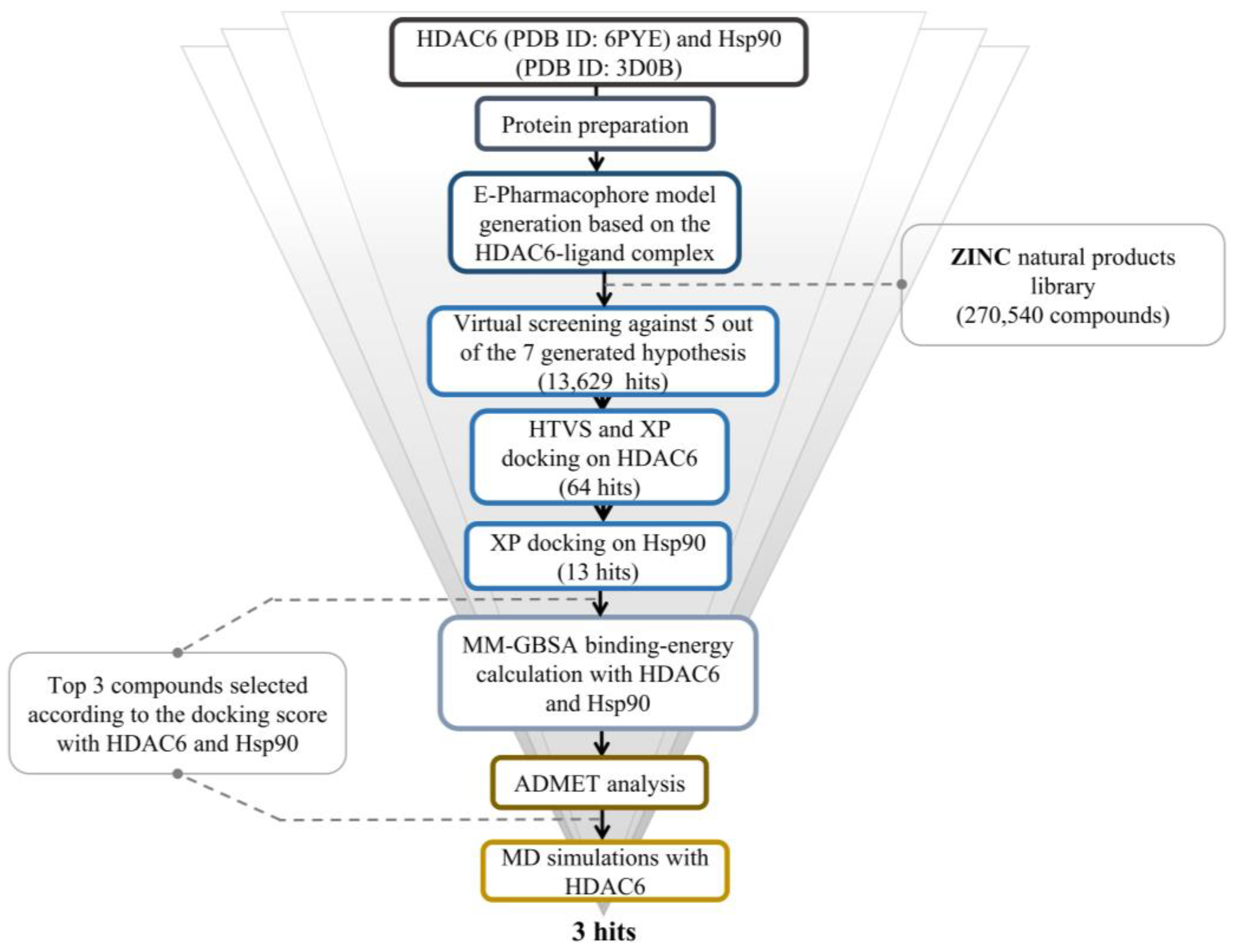
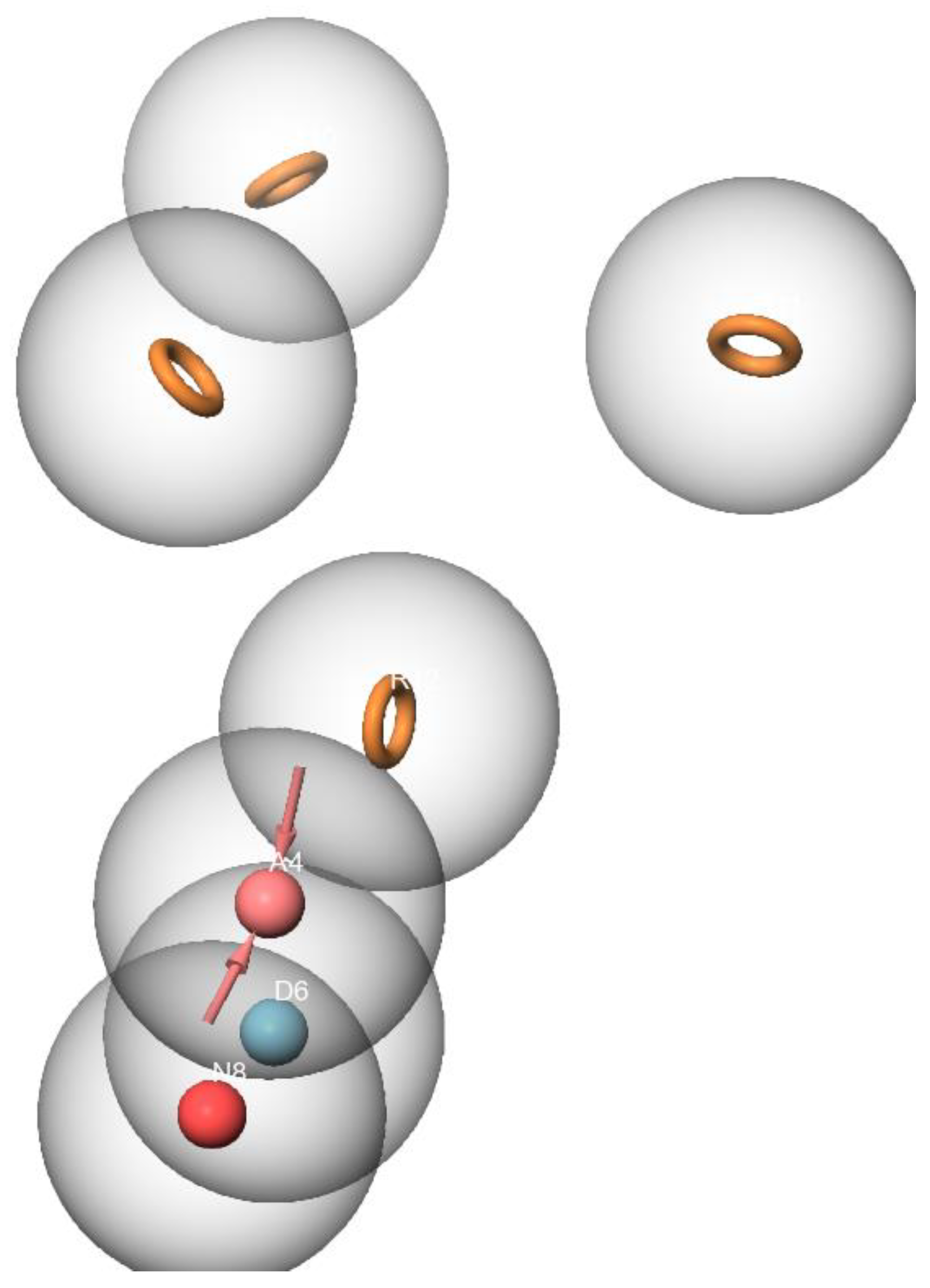
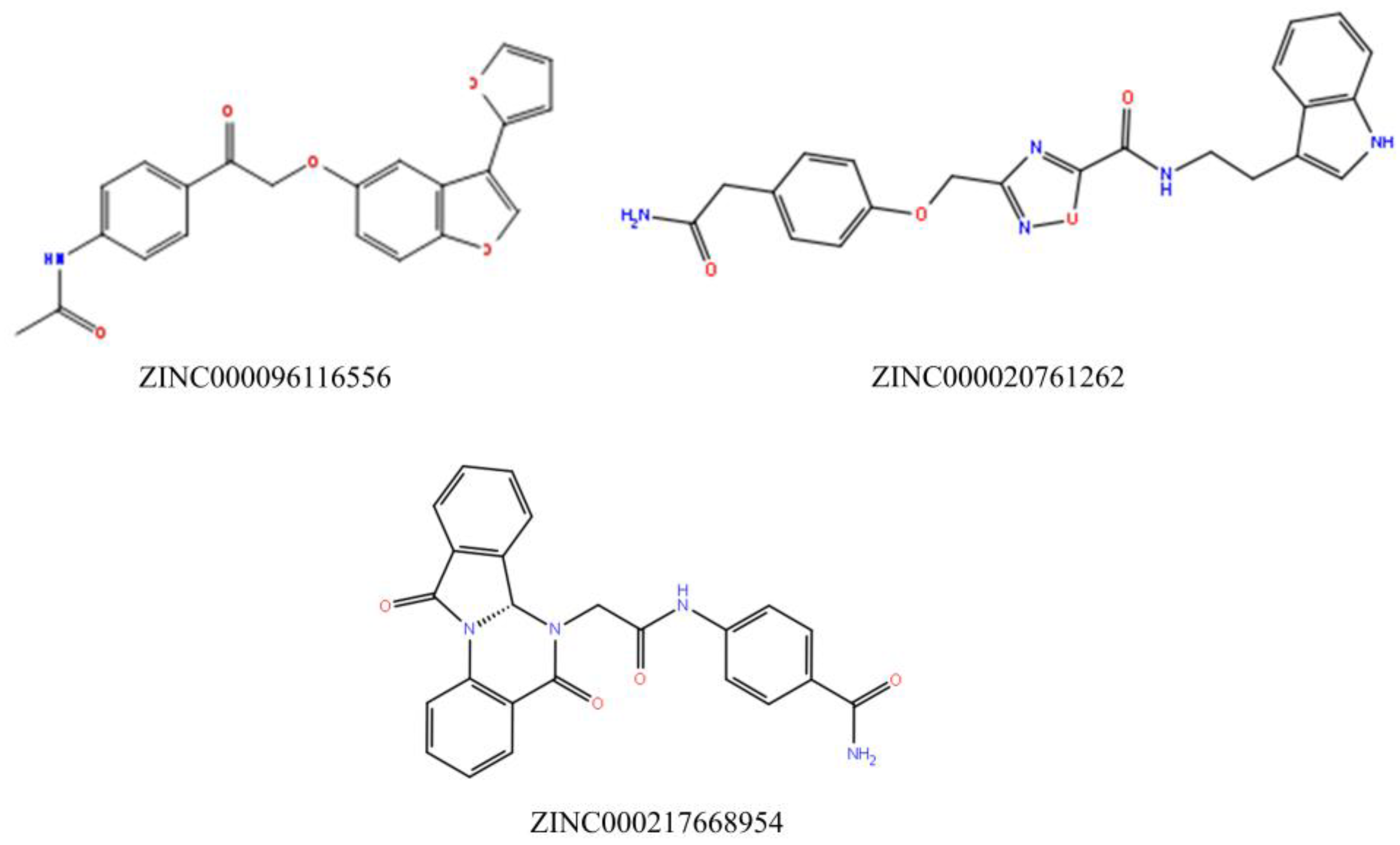
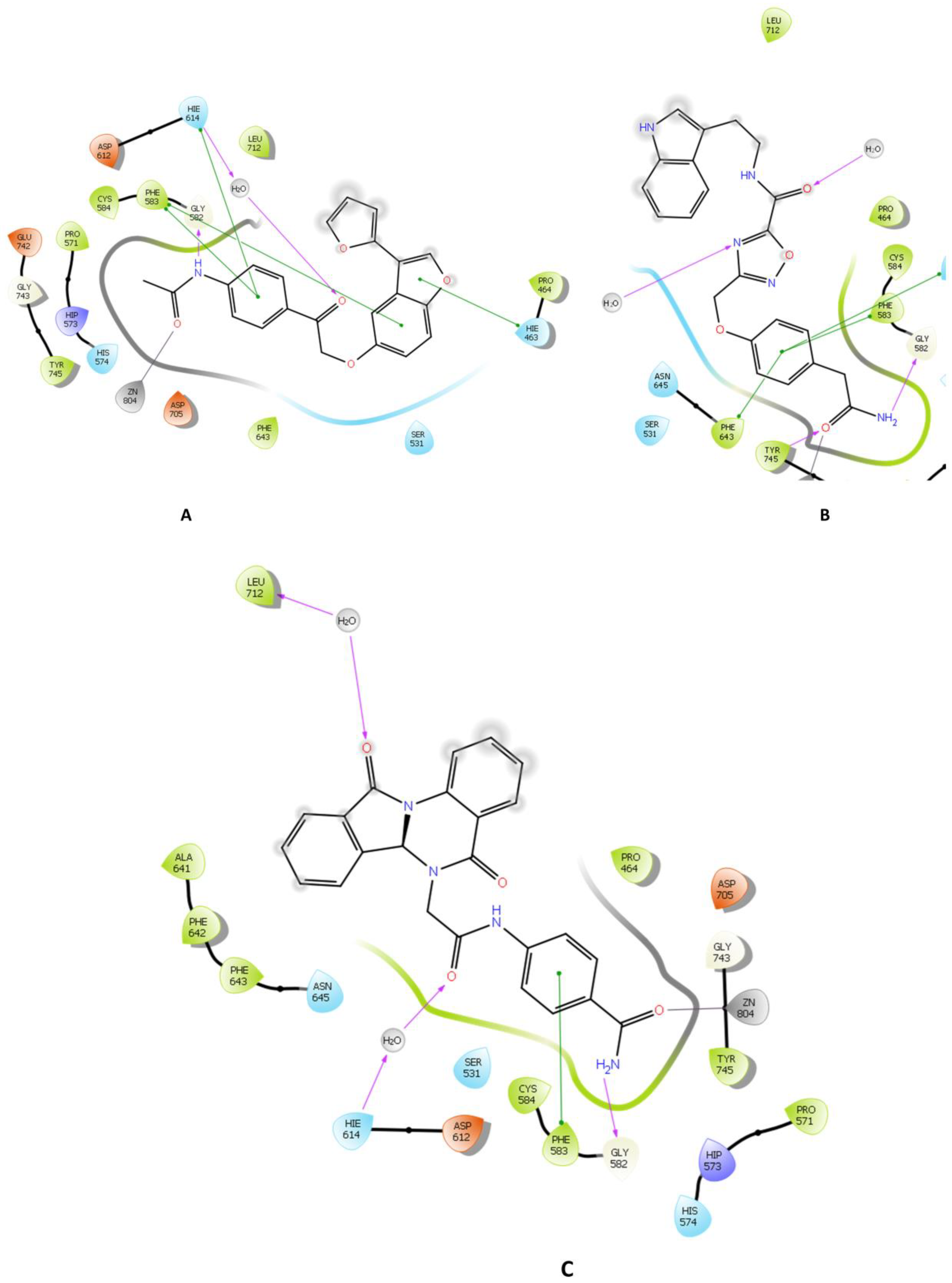
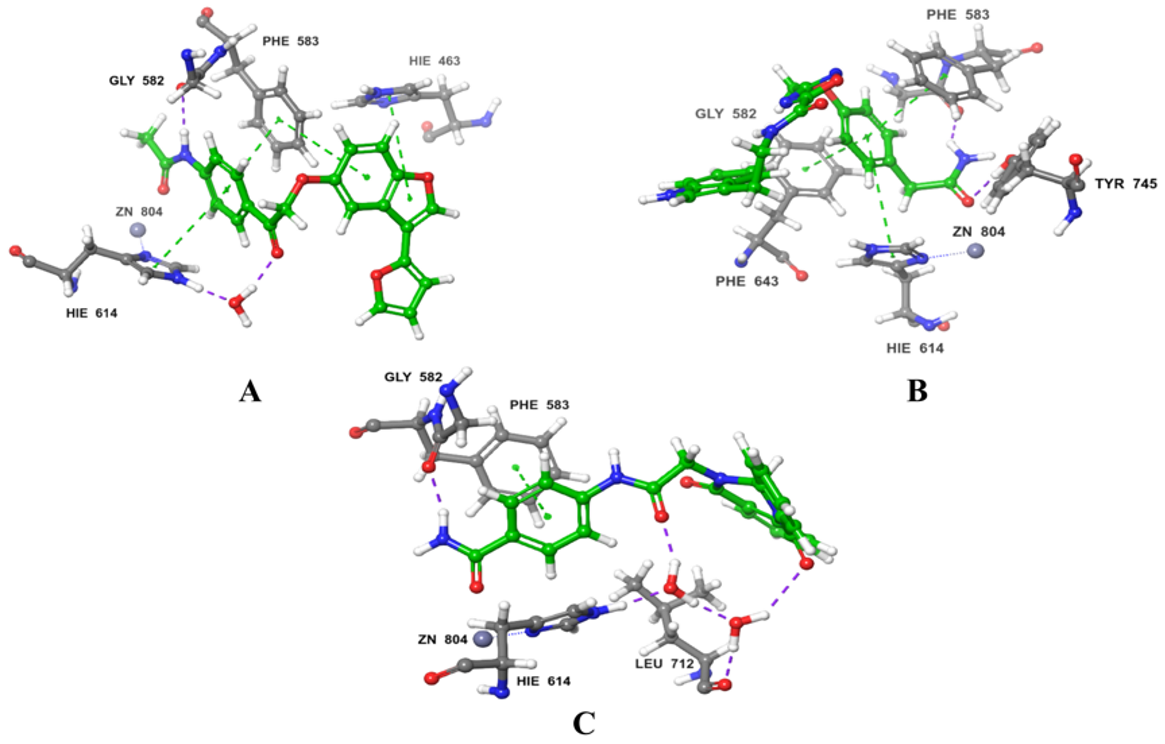
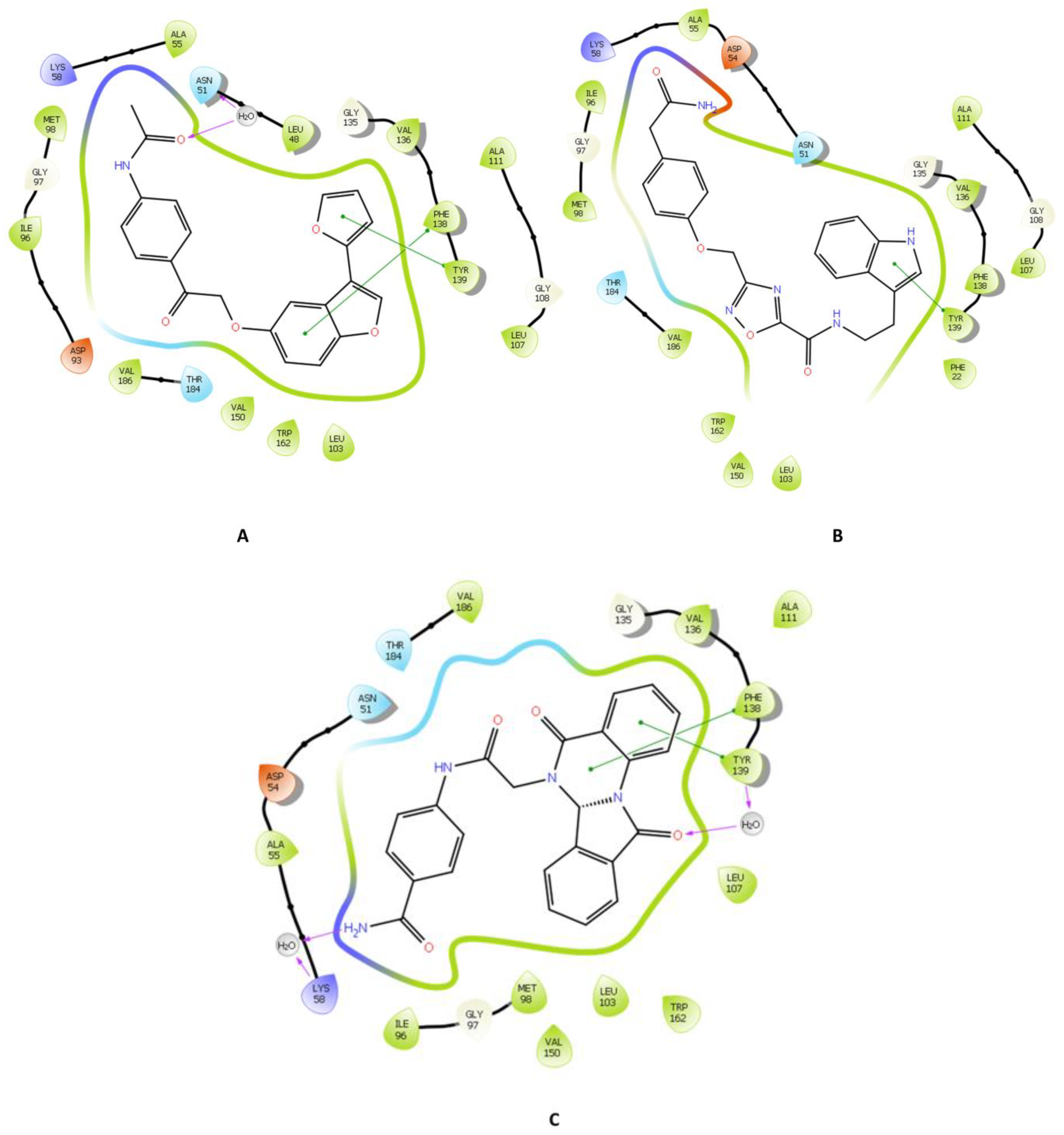
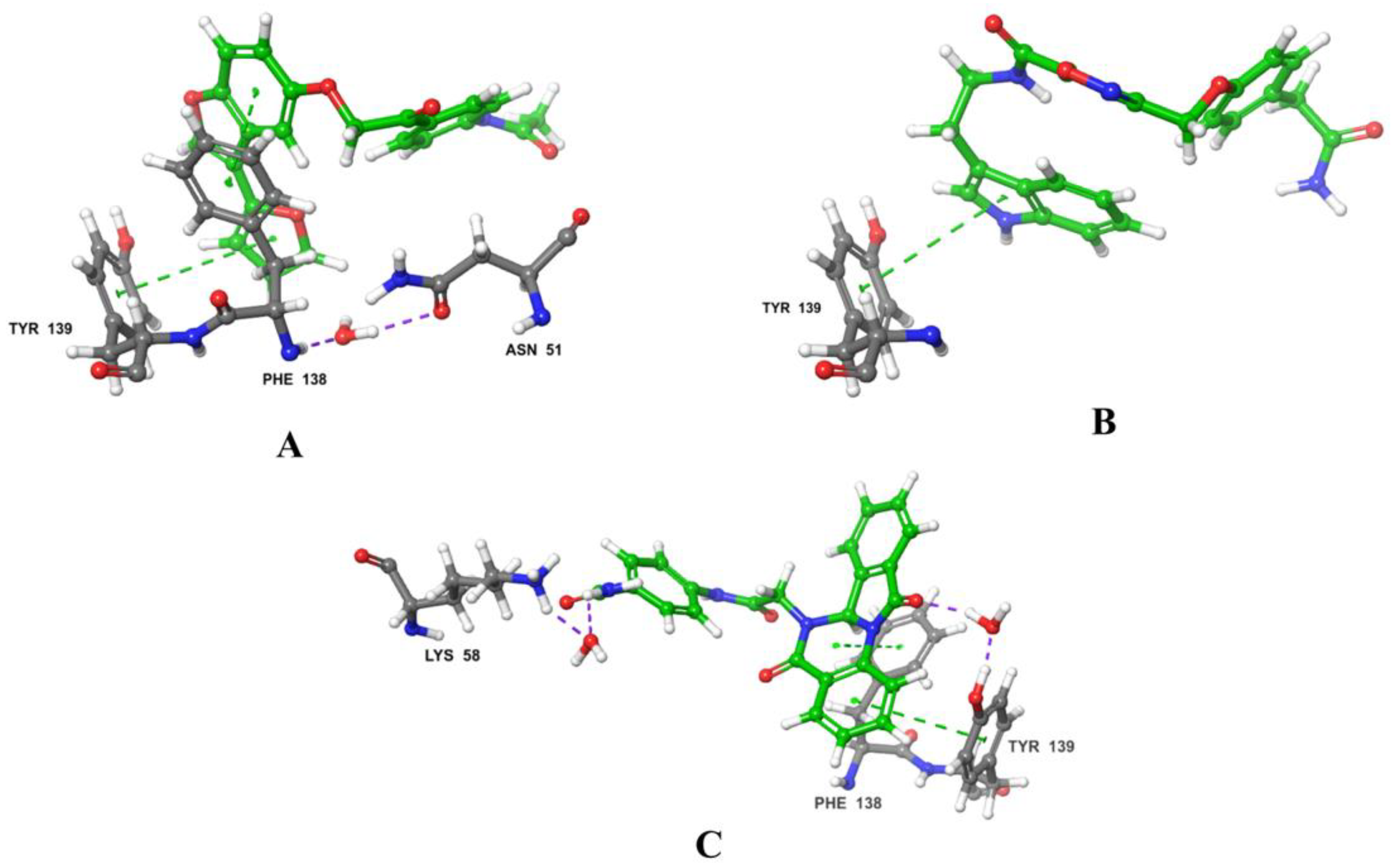
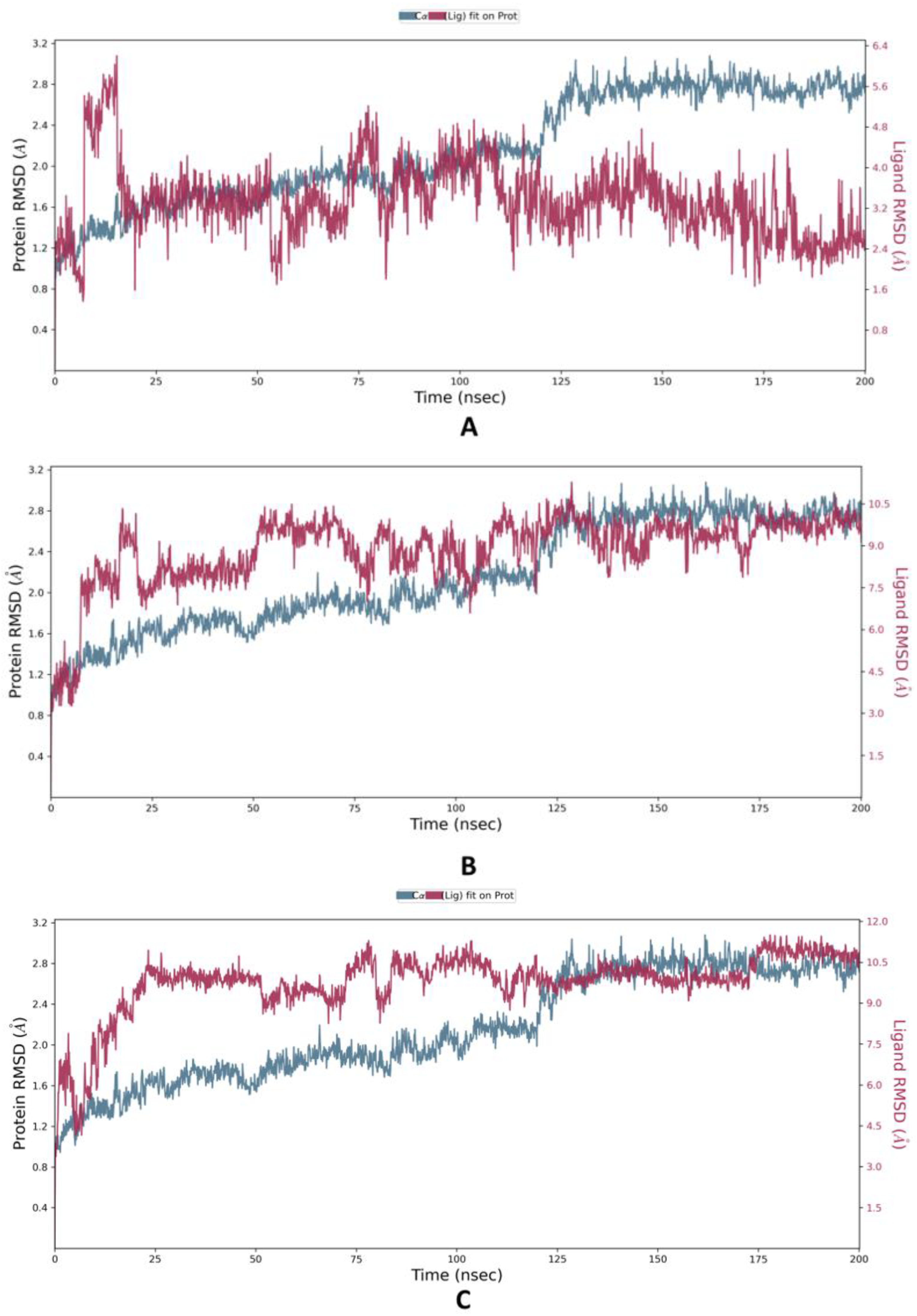
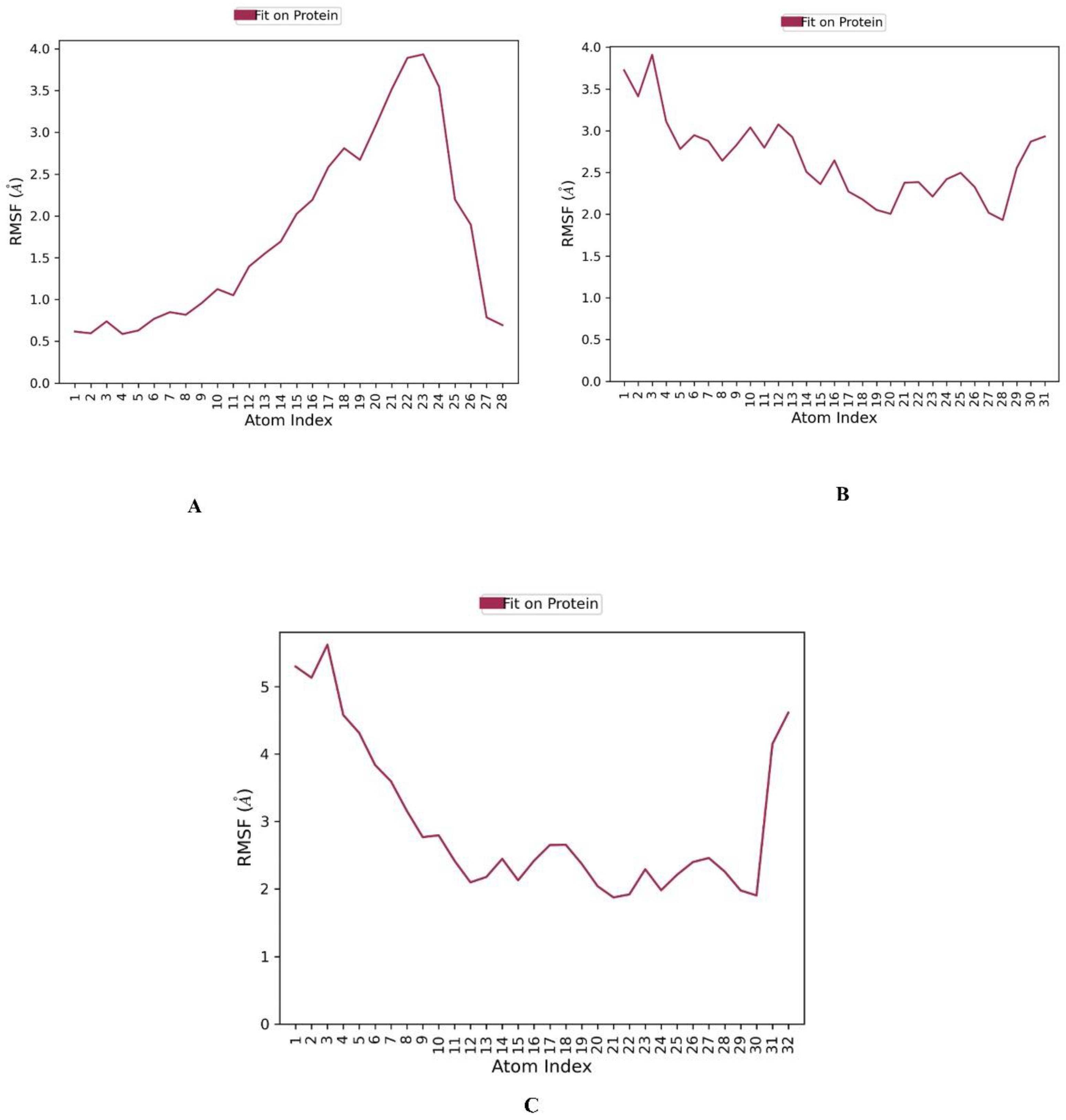
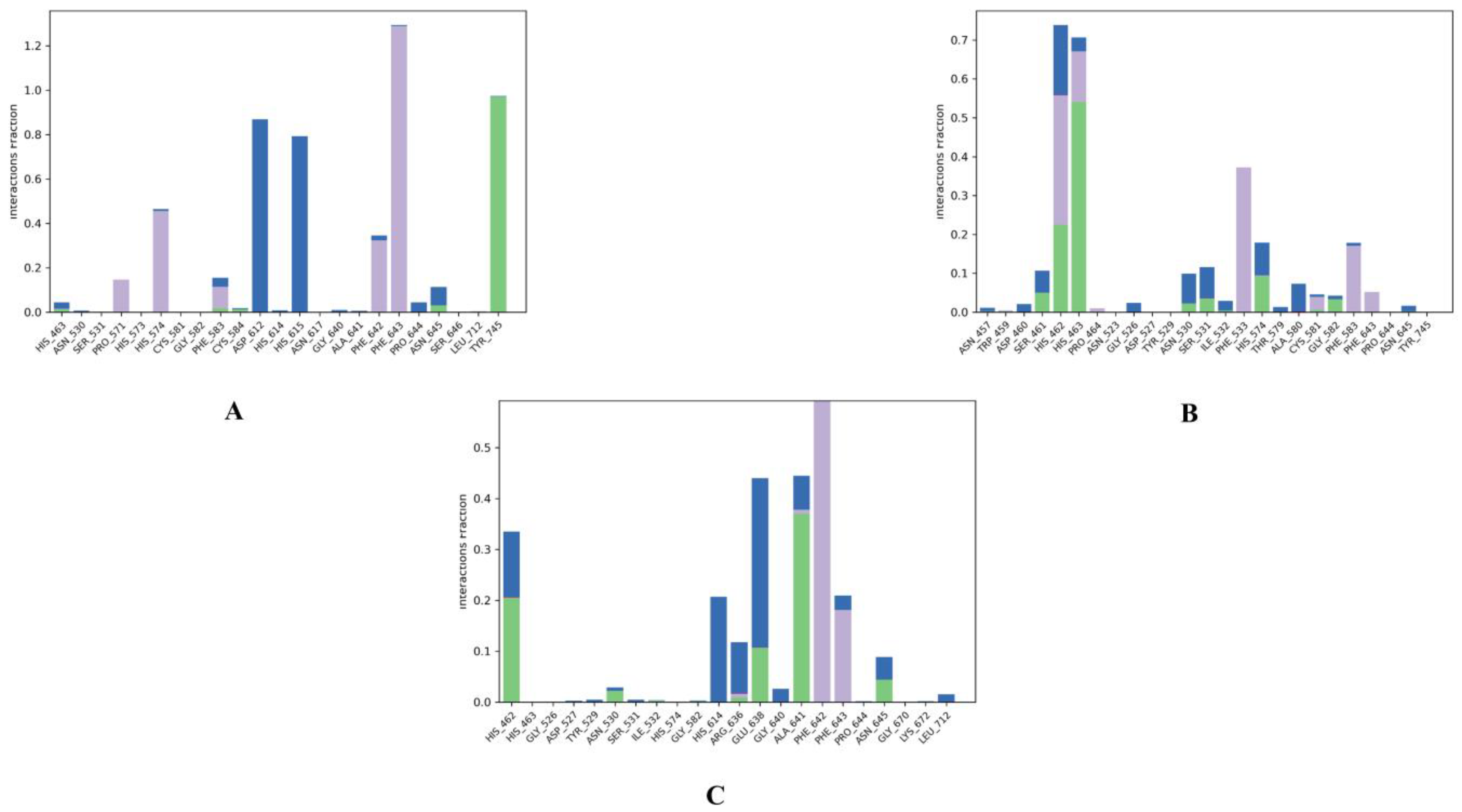
| Name | HDAC6 | Hsp90 | ||
|---|---|---|---|---|
| XP Docking Score (Kcal/mol) | MM-GBSA dG Bind (Kcal/mol) | XP Docking Score (Kcal/mol) | MM-GBSA dG Bind (Kcal/mol) | |
| HDAC6 bound ligand Hsp90 bound ligand ZINC000096116556 | −8.782 - −9.968 | −6.14 - −42.45 | - −15.002 −11.863 | - −84.41 −52.69 |
| ZINC000020761262 ZINC000217668954 | −9.391 −8.977 | −23.19 −23.31 | −8.580 −9.207 | −32.88 −24.66 |
| HDAC6 | ||||
|---|---|---|---|---|
| Name | Pi–pi Interaction (Total) | Hydrogen Bond Interaction (Total) | Hydrophobic Interaction (Total) | Other Interactions (Total) |
| ZINC000096116556 | HIE614, HIE463, PHE583 (3) | HIE614 (1) | CYS584, TYR745, PHE583, PRO571, PRO464, LEU712, PHE643, (7) | Polar interaction: HIS574,SER531, HIE463, HIE614 (4) Charged negative: ASP705, ASP612, GLU742 (3) Charged positive: HIP573 (1) |
| ZINC000020761262 | PHE643, PHE583, HIE614 (3) | GLY582, TYR745, (2) | PHE643, TYR745, PRO571, PHE583, CYS584, PRO464, LEU712 (7) | Polar interaction: HIS574,SER531, HIE614,ASN645 Charged negative: ASP705 Charged positive: HIP573 |
| Hsp90 | ||||
| ZINC000217668954 | PHE583 (1) | HIE614, LEU712, GLY582 (3) | ALA641, PRO464, CYS584, TYR745, PHE643, PHE583, PRO571, PHE642, LEU712 (9) | Polar interaction: HIS574,SER531, HIE614,ASN645 (4) Charged negative: ASP705, ASP612 (2) Charged positive: HIP573 (1) |
| ZINC000096116556 | PHE138 TYR139 (2) | ASN51 (1) | ALA111, LEU107, LEU103, VAL150, TYR139, PHE138, TRP162, VAL136, VAL186, MET98, ILE96, ALA55, LEU48 (13) | Polar interaction: THR184, ASN51 (2) Charged negative: ASP93 (1) Charged positive: LYS58 (1) |
| ZINC000020761262 | TYR139 (1) | - (0) | PHE22, LEU107, VAL136, ALA111, VAL150, LEU103, VAL186, MET98, ILE96, ALA55, TYR139, PHE138, TRP162 (13) | Polar interaction: THR184, ASN51 (2) Charged negative: ASP54 (1) Charged positive: LYS58 (1) |
| ZINC000217668954 | PHE138 TYR139 (2) | LYS58, TYR139 (2) | TRP162, LEU103, TYR139, PHE138, LEU107, VAL150, ALA55, MET98, ILE96, VAL186, VAL136, ALA111 (12) | Polar interaction: THR184, ASN51 (2) Charged negative: ASP54 (1) Charged positive: LYS58 (1) |
| Drug-Likeness/Predicted ADME Descriptors | QPlogPo/w | QPlogS | CIQPlogS | QPlogHERG | QPPCaco | QPlogBB | QPPMDCK | Human Oral Absorption | %Human Oral Absorption | Rule of Five |
|---|---|---|---|---|---|---|---|---|---|---|
| ZINC000096116556 | 3.779 | −5.141 | −5.547 | −6.631 | 1480.139 | −0.618 | 755.835 | 3 | 100 | 0 |
| ZINC000217668954 | 1.476 | −4.479 | −4.819 | −6.751 | 105.569 | −1.797 | 43.542 | 3 | 71.807 | 0 |
| ZINC000020761262 | 1.011 | −2.254 | −4.679 | −3.945 | 21.522 | −2.276 | 18.642 | 2 | 56.718 | 0 |
| 6PYE bound ligand | 3.417 | −5.978 | −6.843 | −7.348 | 100.046 | −2.123 | 113.473 | 2 | 69.793 | 1 |
| ZINC000096116556 | ZINC000217668954 | ZINC000020761262 | |
|---|---|---|---|
| RMSD | 0.9659 ± 0.3655 | 2.406 ± 0.3266 | 1.701 ± 0.2344 |
| rGyr | 5.630 ± 0.1830 | 5.990 ± 0.3141 | 5.294 ± 0.1081 |
| SASA | 259.0 ± 29.50 | 477.5 ± 38.48 | 553.1 ± 53.04 |
| MolSA | 358.5 ± 1.674 | 429.5 ± 2.826 | 411.9 ± 2.248 |
| intraHB | 0.0 ± 0.0 | 0.0004995 ± 0.02235 | 0.01499 ± 0.1215 |
| PSA | 130.1 ± 4.000 | 264.6 ± 6.270 | 237.8 ± 4.264 |
Disclaimer/Publisher’s Note: The statements, opinions and data contained in all publications are solely those of the individual author(s) and contributor(s) and not of MDPI and/or the editor(s). MDPI and/or the editor(s) disclaim responsibility for any injury to people or property resulting from any ideas, methods, instructions or products referred to in the content. |
© 2023 by the authors. Licensee MDPI, Basel, Switzerland. This article is an open access article distributed under the terms and conditions of the Creative Commons Attribution (CC BY) license (https://creativecommons.org/licenses/by/4.0/).
Share and Cite
AbdElmoniem, N.; H. Abdallah, M.; M. Mukhtar, R.; Moutasim, F.; Rafie Ahmed, A.; Edris, A.; Ibraheem, W.; Makki, A.A.; M. Elshamly, E.; Elhag, R.; et al. Identification of Novel Natural Dual HDAC and Hsp90 Inhibitors for Metastatic TNBC Using e-Pharmacophore Modeling, Molecular Docking, and Molecular Dynamics Studies. Molecules 2023, 28, 1771. https://doi.org/10.3390/molecules28041771
AbdElmoniem N, H. Abdallah M, M. Mukhtar R, Moutasim F, Rafie Ahmed A, Edris A, Ibraheem W, Makki AA, M. Elshamly E, Elhag R, et al. Identification of Novel Natural Dual HDAC and Hsp90 Inhibitors for Metastatic TNBC Using e-Pharmacophore Modeling, Molecular Docking, and Molecular Dynamics Studies. Molecules. 2023; 28(4):1771. https://doi.org/10.3390/molecules28041771
Chicago/Turabian StyleAbdElmoniem, Nihal, Marwa H. Abdallah, Rua M. Mukhtar, Fatima Moutasim, Ahmed Rafie Ahmed, Alaa Edris, Walaa Ibraheem, Alaa A. Makki, Eman M. Elshamly, Rashid Elhag, and et al. 2023. "Identification of Novel Natural Dual HDAC and Hsp90 Inhibitors for Metastatic TNBC Using e-Pharmacophore Modeling, Molecular Docking, and Molecular Dynamics Studies" Molecules 28, no. 4: 1771. https://doi.org/10.3390/molecules28041771
APA StyleAbdElmoniem, N., H. Abdallah, M., M. Mukhtar, R., Moutasim, F., Rafie Ahmed, A., Edris, A., Ibraheem, W., Makki, A. A., M. Elshamly, E., Elhag, R., Osman, W., A. Mothana, R., & Alzain, A. A. (2023). Identification of Novel Natural Dual HDAC and Hsp90 Inhibitors for Metastatic TNBC Using e-Pharmacophore Modeling, Molecular Docking, and Molecular Dynamics Studies. Molecules, 28(4), 1771. https://doi.org/10.3390/molecules28041771






